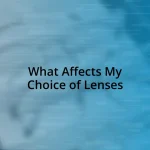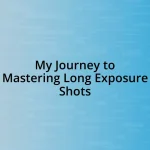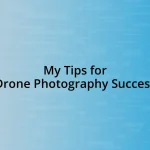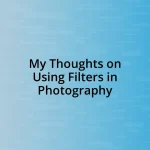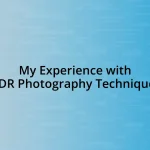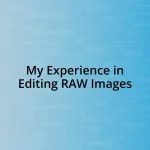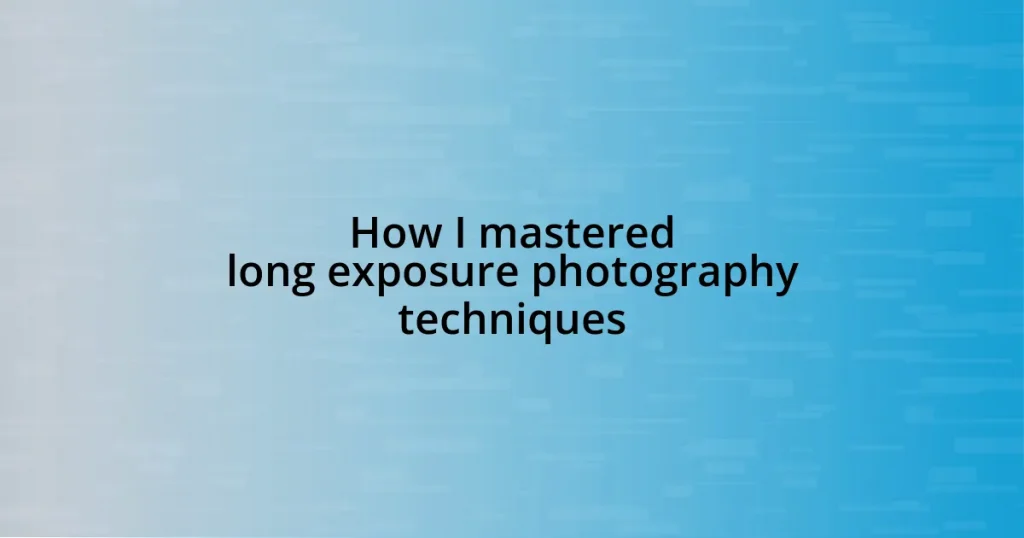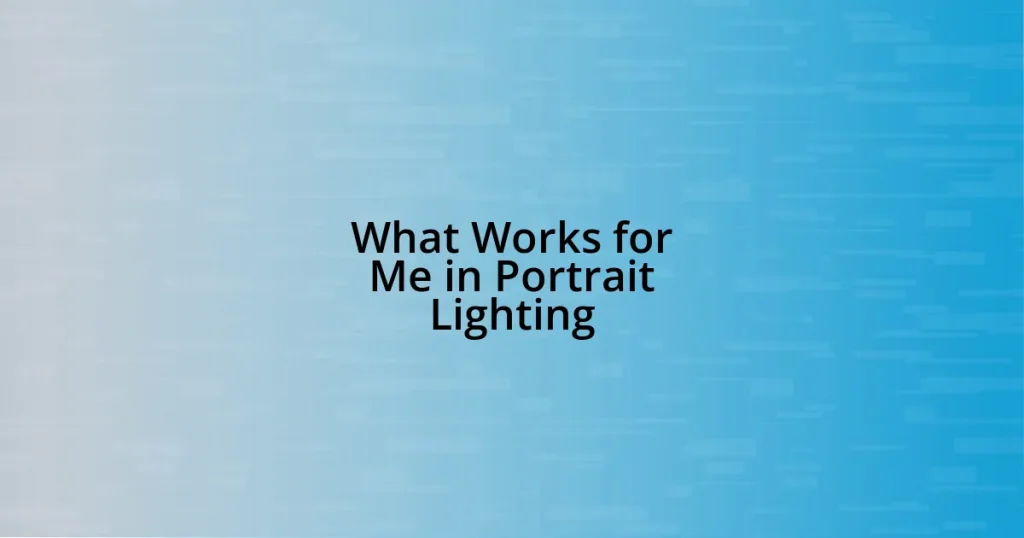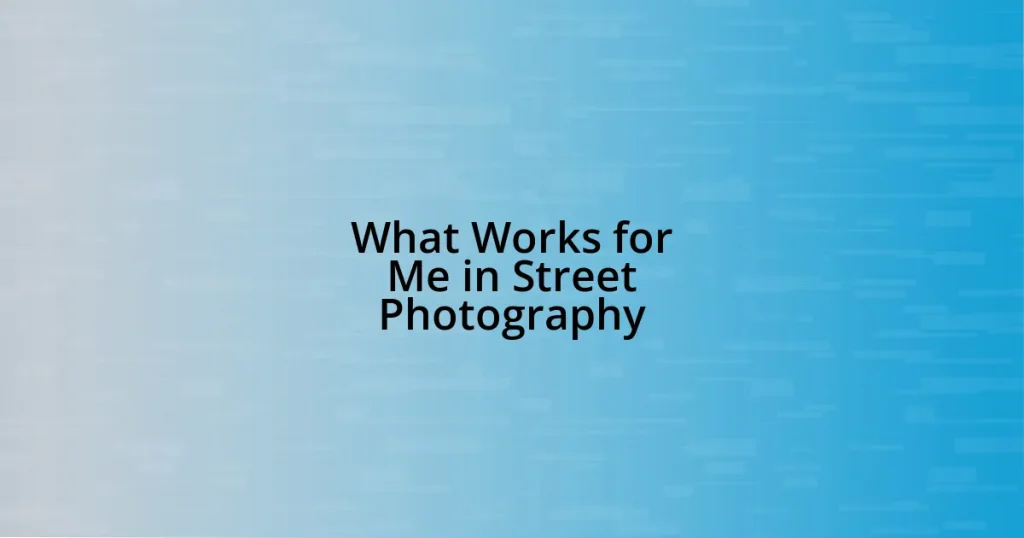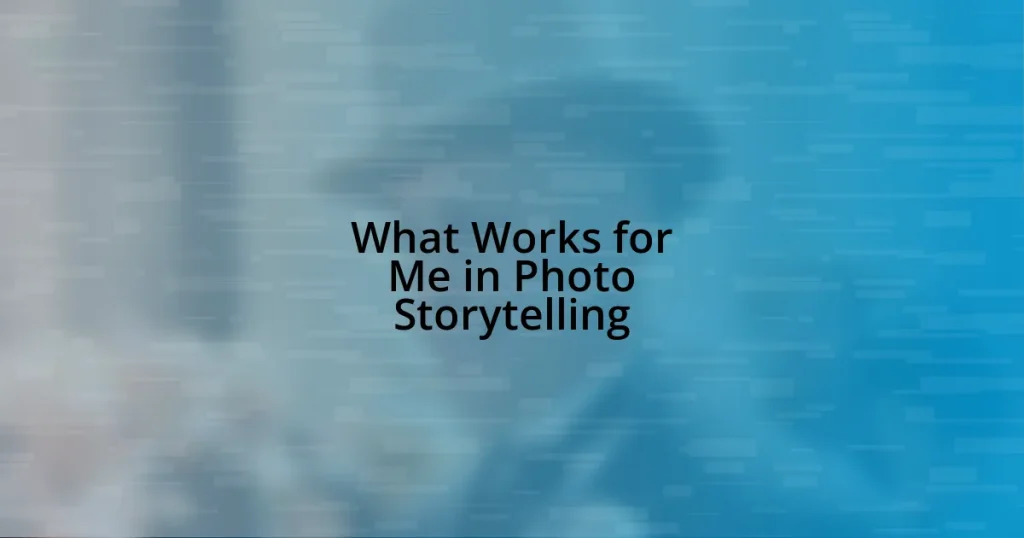Key takeaways:
- Long exposure photography captures the passage of time, transforming ordinary scenes into captivating images through extended shutter speeds.
- The right equipment, including a sturdy tripod, ND filter, and remote shutter release, is crucial for achieving stable and high-quality long exposure shots.
- Camera settings such as low ISO, smaller aperture (f/8 to f/11), and varied shutter speeds are essential for creating impactful long exposure images.
- Post-processing enhances long exposure photos by adjusting exposure, contrast, clarity, and removing distractions to fully realize the photographer’s vision.
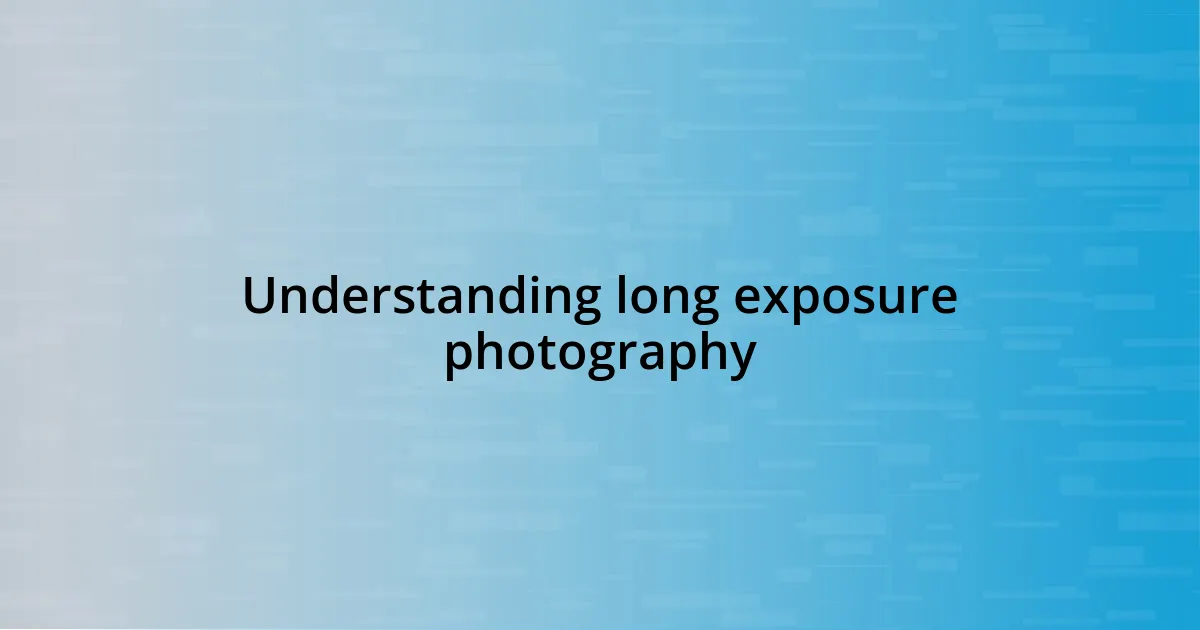
Understanding long exposure photography
Long exposure photography is an art form that captures the passage of time within a single frame. I remember the first time I attempted it; I was at a beach during sunset, exhilarated by how the water became a silky blur against the jagged rocks. It made me wonder, how can something so simple transform an ordinary scene into a mesmerizing experience?
The essence of long exposure lies in the extended duration the camera’s shutter remains open, allowing more light to enter. This technique reveals a world that our eyes may overlook, like the ethereal trails of stars or smooth waves that dance in the moonlight. Have you ever thought about how many stories a single image can tell when time is stretched like this? It’s as if the photograph breathes life into a fleeting moment.
As I delved deeper into this technique, I discovered that patience is key. I often found myself setting up my tripod with bated breath, eager to see the result, yet knowing it could take several attempts to achieve the desired effect. There’s something incredibly rewarding about the anticipation and eventual revelation that comes with mastering long exposure; it teaches you to savor both the process and the outcome.

Importance of equipment selection
When I first embraced long exposure photography, I quickly learned that the right equipment can make or break a shot. Choosing a sturdy tripod was my first priority; the last thing I wanted was to chase away my vision because of camera shake. I remember a time trying to capture the Northern Lights—my enthusiasm was dampened when I realized how wobbly my flimsy tripod was, impacting my composition. It was a valuable lesson in stability and precision.
To amplify your long exposure success, consider these essential pieces of equipment:
- Tripod: A stable platform is crucial for those extended shutter speeds.
- Neutral Density (ND) Filter: This allows for longer exposures without overexposing the image, especially in bright conditions.
- Remote Shutter Release: Helps eliminate camera shake, allowing you to trigger the shutter without touching the camera.
- Wide-Angle Lens: Perfect for capturing expansive scenes, especially landscapes where you want to absorb as much detail as possible.
- High-Quality Camera: A DSLR or mirrorless camera typically offers better control over exposure settings, making it ideal for long exposure work.
Selecting the right tools not only enhances your creative possibilities but also fosters a deep connection with your art and the scenes you wish to immortalize. I can’t help but feel a sense of joy when I finally see how the right equipment complements the vision I had in mind.
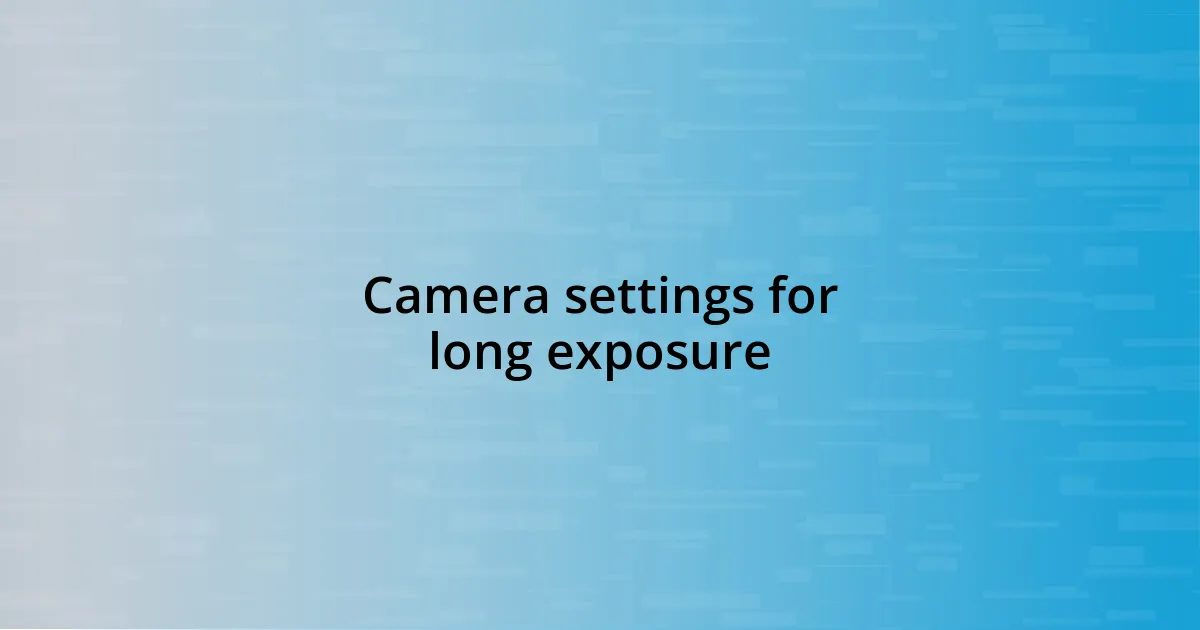
Camera settings for long exposure
When it comes to camera settings, I’ve discovered that every fine detail plays a significant role in achieving breathtaking long exposure shots. For starters, I usually set my camera to Manual mode. This allows complete control over both aperture and shutter speed. I tend to lower my ISO to 100 or 200, which reduces noise and enhances clarity in the final image. I remember the time I forgot to adjust my ISO and ended up with a grainy night shot—it was a reminder that every setting counts.
Another critical setting is the aperture. I often use a smaller aperture (higher f-stop number) like f/8 or f/11. This increases the depth of field and keeps everything in sharp focus, which I find essential when capturing landscapes. During my trip to a serene lake, I employed an aperture of f/9, leading to stunning details in both the foreground and background—definitely a moment of validation for my technique.
Lastly, the shutter speed is where the magic truly happens. Depending on the scene, I experiment with various shutter speeds, ranging from several seconds to even minutes. I remember once leaving my shutter open for 30 seconds while shooting busy city streets. The result was mesmerizing, as the flowing movement of cars created beautiful light trails, transforming the ordinary into something extraordinary. Experimenting with these settings is not just about technicality; it’s also about intuitively feeling the essence of a scene.
| Camera Setting | Recommended Value |
|---|---|
| ISO | 100-200 |
| Aperture | f/8 to f/11 |
| Shutter Speed | Several seconds to minutes |
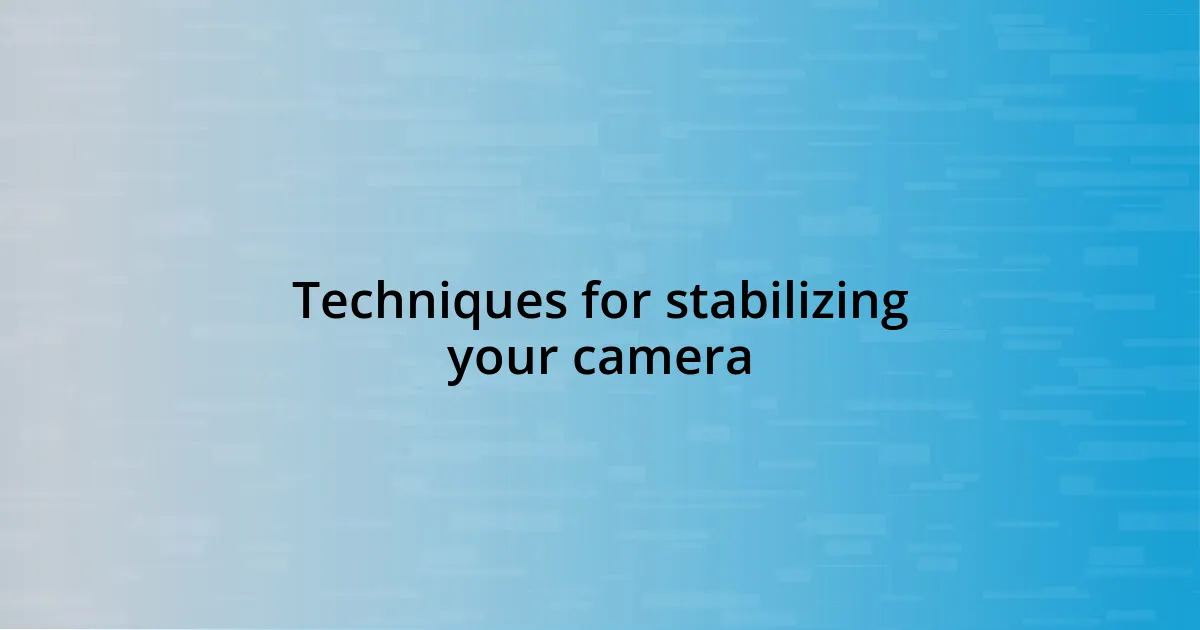
Techniques for stabilizing your camera
To ensure that my camera remains steady during long exposures, investing in a high-quality tripod is essential. I’ll never forget setting up my equipment on a windy clifftop. The gusts were fierce, but my sturdy tripod held firm, allowing me to capture the breathtaking sunset without any wobble. It’s amazing how just one piece of equipment can make all the difference in maintaining stability.
Another technique that has greatly improved my stability is using a remote shutter release. I remember the first time I used one; I was amazed by how much it reduced camera shake. It’s like having an invisible assistant activate the shutter for me. Can you imagine how many perfect shots I would have missed if I hadn’t made this small adjustment to my routine?
Lastly, I often brace my camera against solid surfaces when a tripod isn’t an option. During a late-night shoot at a local pier, I cleverly leaned my camera against a railing. It felt like a risky decision, but it paid off handsomely when I managed to capture a crystal-clear, reflective shot of the skyline on the water. Each of these stabilizing techniques has enhanced my long exposure photography experience and opened my eyes to the limitless possibilities that arise from a steady shot.
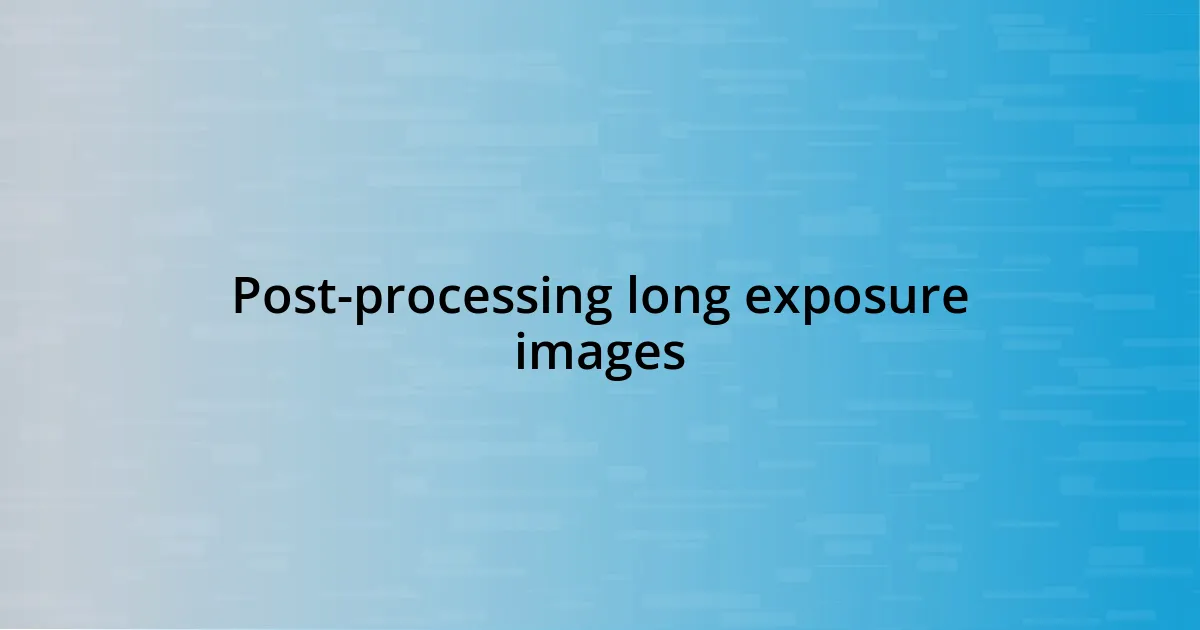
Post-processing long exposure images
Post-processing long exposure images is where the real magic begins. After uploading my long exposure shots, the first thing I usually delve into is adjusting the exposure and contrast. I recall a breathtaking seascape I shot at sunrise, where the colors felt muted right out of the camera. A few tweaks in Lightroom brought the depth of those vibrant hues back to life. Isn’t it fascinating how a little adjustment can transform the mood of an image entirely?
Next, I often play with the clarity and sharpness settings. I remember my excitement when I learned to enhance the silky texture of water while retaining the sharpness of the surrounding rocks. This balance creates a dreamlike quality—like stepping into a painting. Have you ever wondered how much detail can be revealed with just the slightest adjustments? Learning to navigate these settings has helped me to emphasize what I want to portray in a scene, making the viewer feel the moment.
Finally, I can’t stress enough the importance of removing distractions. In one of my favorite shots, there was an unwanted streetlight peeking into the frame. With simple healing tools, I was able to eliminate it without a trace. It’s like decluttering a room; once you remove the unnecessary, the true beauty of your image shines through more vividly. Each time I refine my post-processing techniques, I become more attuned to my creative vision, and isn’t that a rewarding journey?




